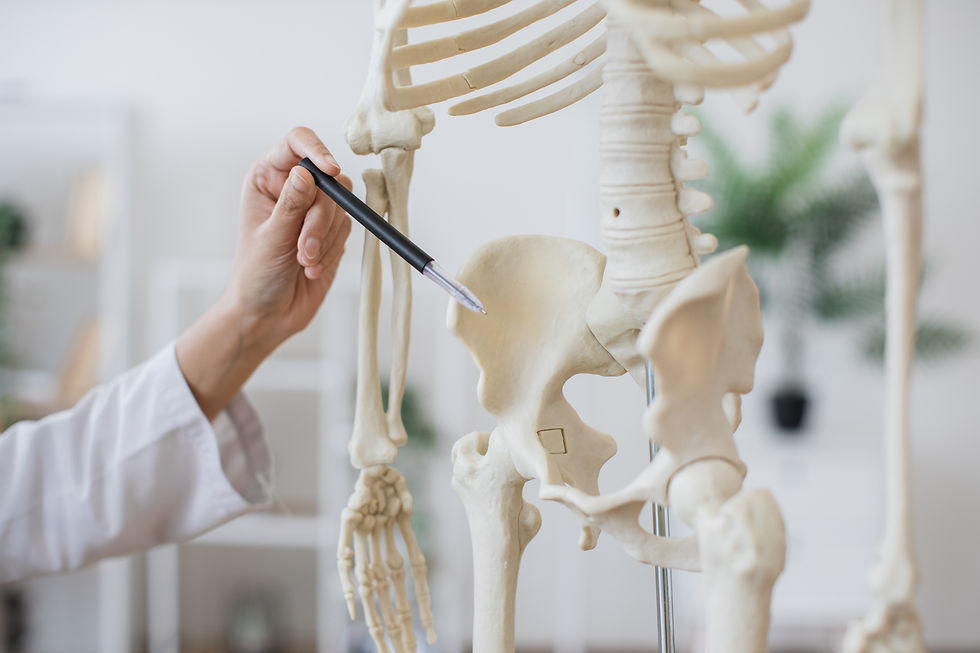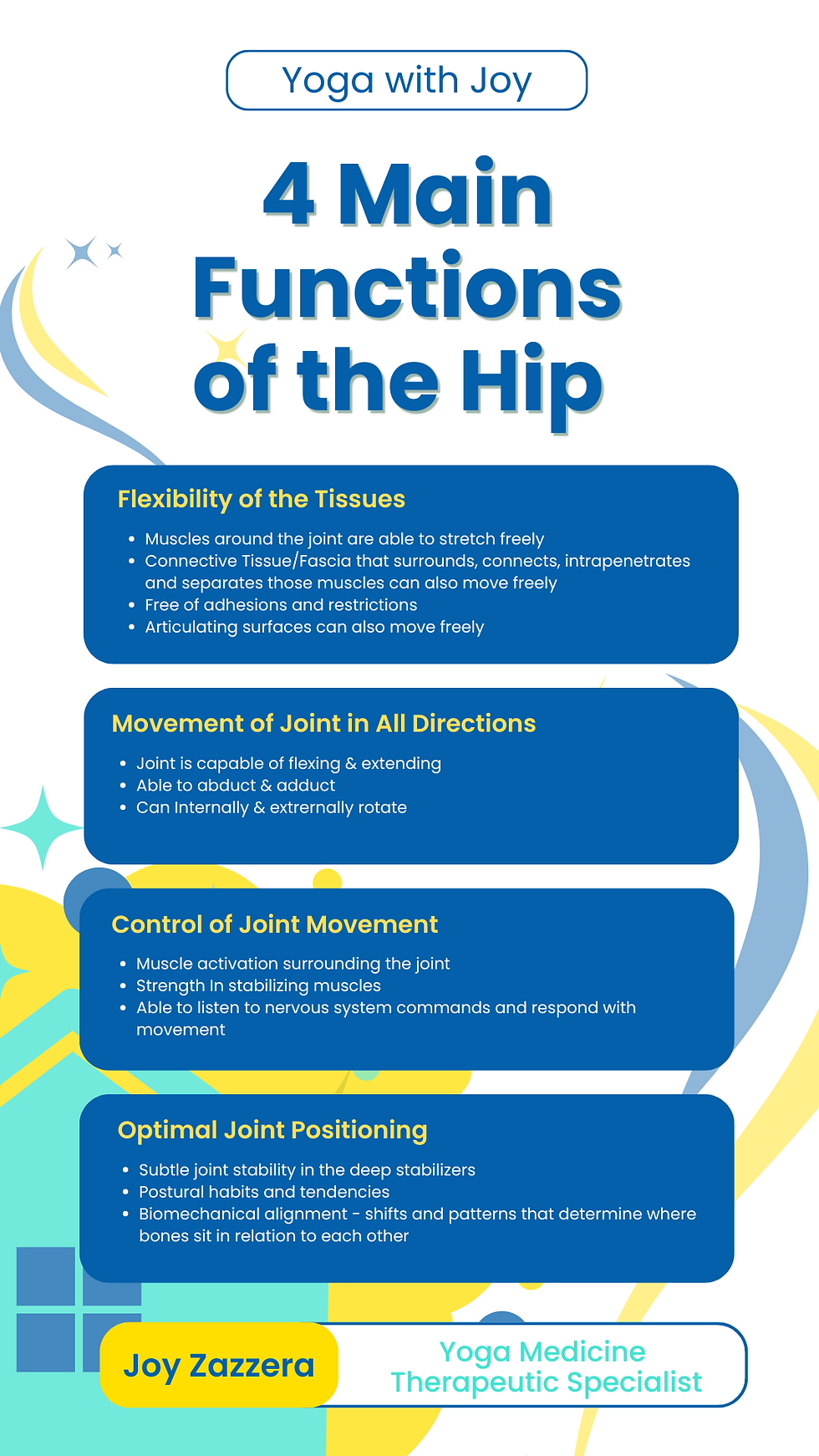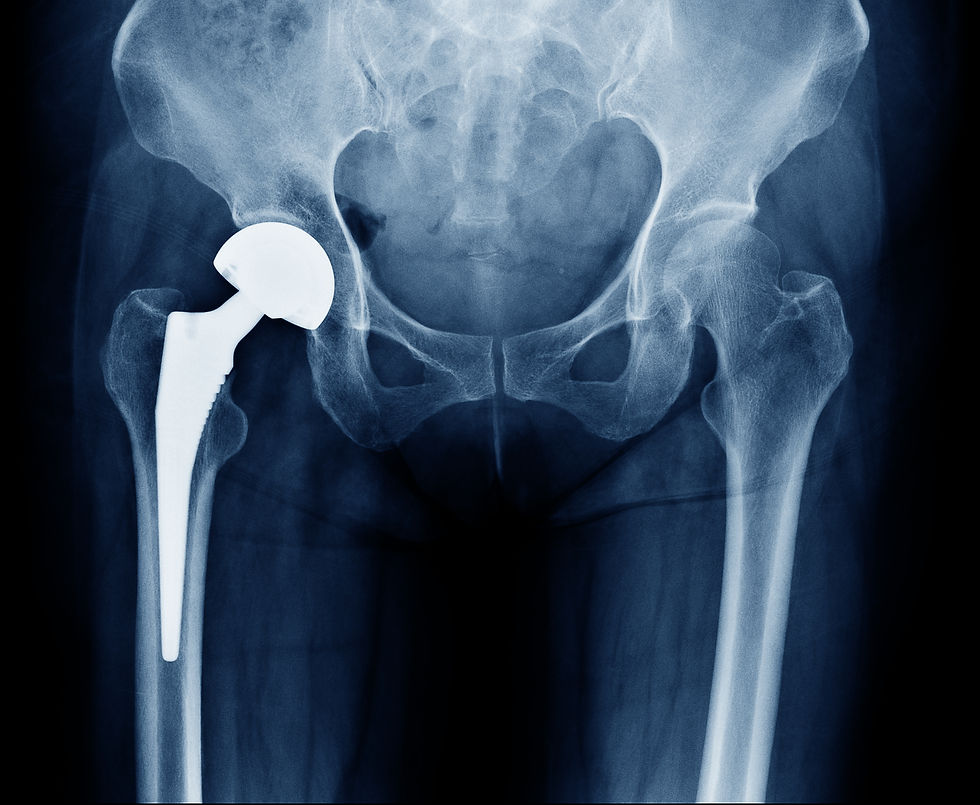Yoga for Osteoarthritis and Hip Replacements: Safe Movement for Joint Pain Relief and Recovery
- Joy Zazzera

- Nov 3, 2024
- 4 min read
Updated: Aug 6
If we’re lucky enough to live a long life, we’ll all experience some form of joint degeneration. That may sound grim, but it doesn’t have to be. Osteoarthritis (OA)—a common degenerative joint condition—can be managed, and even improved, with the right support. And for those living with hip replacements, there’s hope in knowing that healing is possible with movement that’s both mindful and biomechanically informed.
As a Yoga Medicine Therapeutic Specialist, I support clients who are navigating pain, stiffness, or surgery recovery through yoga therapeutics. Whether you're living with OA or adapting to a new joint, my goal is to help you optimize function, reduce stress on tissues, and build a more resilient system—without pushing past what your body can truly support.

Understanding Osteoarthritis and Hip Joint Function
Osteoarthritis is a condition marked by the breakdown of articular cartilage—the smooth tissue that cushions the ends of bones in a joint. While cartilage itself doesn’t have nerve endings, the underlying bone does. That’s why people with OA often feel pain, not because cartilage is “worn out,” but because the exposed bone becomes irritated.
OA can be age-related, genetic, or related to joint biomechanics—how we move, bear weight, and adapt (or don’t) to stress over time.
In yoga therapeutics, we don’t try to reverse cartilage loss. Instead, we work to:
Optimize joint mechanics
Reduce compressive loads
Improve tissue adaptability
Support the nervous system through breath and awareness
The Hip Joint: Designed for Load, Not Long Sitting
The hip—known anatomically as the acetabulofemoral joint—is a ball-and-socket joint, deeply embedded in a strong capsule surrounded by connective tissue and musculature. Unlike the shoulder, which prioritizes mobility, the hip is built for stability, jumping, walking, and weight-bearing. That means sitting for long periods (which reduces blood flow and compresses tissues) isn’t what it was designed for. This joint also has tremendous structural variability. Every body is different—socket depth, femoral angle, and rotational capacity all influence how each of us moves. The goal in yoga therapeutics isn’t to hit end ranges or “ideal” poses—it’s to help people enter and exit positions with more ease and less strain.
Four Foundations of Healthy Hip Function
A healthy, happy hip joint depends on these four components:
1. Flexibility of Tissues
Muscles and connective tissue (like fascia) need to allow for movement and stretch.
Free movement of surrounding structures improves how the joint articulates.
Restrictions or adhesions can limit motion and increase wear.
2. Movement in All Directions
The hip needs to flex, extend, abduct, adduct, and rotate in both directions.
Limited directional movement often leads to overuse of compensatory patterns.
3. Control of Joint Movement
Strength and muscle activation matter, especially in the smaller stabilizers.
We train the nervous system to respond with better motor control, not just brute strength.
4. Optimal Joint Positioning
Postural habits, load patterns, and muscular balance all affect how bones align.
Teaching mindful movement means helping students feel where and how their hips are positioned in space.

When Hip Replacement Becomes Necessary
In some cases, a joint wears down enough to require surgical replacement. A hip replacement involves placing a prosthetic joint—made from composites like titanium, ceramic, or plastic—into the body. It can be partial or total, and while it comes with pros and cons, many people experience dramatic improvements in pain and mobility.
But healing doesn’t end at surgery.
Post-operative care is critical. The first step after a hip replacement should always be participation in a structured physical therapy program, guided by your medical team. Once initial healing has occurred and your orthopedic surgeon has given you clearance, a therapeutic yoga program can support your continued recovery by helping you rebuild neuromuscular support, improve movement patterns, and regain confidence in your body. The first 8–12 weeks are especially important for:
Avoiding deep internal rotation and flexion
Preventing dislocation
Rebuilding neuromuscular support
Not pushing deep ROM or end ranges
When beginning a yoga therapeutics program, we focus on stabilization, balanced loading, and safe re-patterning—all through gentle, mindful movement.

How Yoga Therapeutics Supports Recovery and Resilience
A therapeutic yoga practice after joint replacement or in the presence of OA is not about stretching more—it’s about moving better. We build resilience, not range.
This includes:
Gentle myofascial release (avoiding direct pressure on the joint post-surgery)
Supporting the hip via the tension system (glutes, psoas, iliacus, QL, etc.)
Improving circulation, balance, and nervous system regulation
Honoring limitations while slowly increasing load to stimulate adaptation
Most importantly, we start with what’s challenging but doable, and let the tissues adapt from there.
Final Thought: Movement as Medicine
Degeneration often carries a negative stigma. But aging, change, and adaptation are part of being human. Yoga doesn’t fix your joints—it helps you live better in your body.
Every step you take toward mindful movement is a step toward less pain and more freedom. Your hips are built for weight-bearing and resilience—not stillness or strain. Whether you're navigating osteoarthritis or healing from a replacement, therapeutic yoga offers a path to rebuild strength, restore mobility, and reconnect with your body in a way that feels safe and empowering.
Through thoughtful movement, compassionate teaching, and evidence-informed tools, we can support our joints in doing what they were meant to do: move, bear weight, and carry us through life with steadiness and ease. With small, consistent inputs—like breath, alignment, and gentle strength—you can reduce pain, support your nervous system, and move forward with confidence.
Your body can adapt—and with the right support, it can move with greater strength, ease, and trust.







Comments